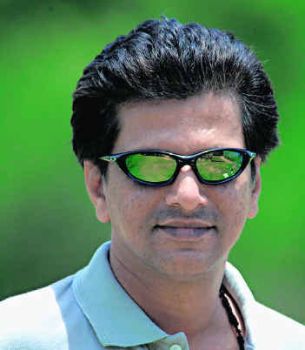
W.V. Raman.
Many left-handed batsmen have served Tamil Nadu cricket splendidly. Among post-War players, A.G. Milkha Singh, Abdul Jabbar, W.V. Raman, R. Madhavan, S. Sharath, and S. Sriram have been some of the State’s successful southpaws in the middle order, while P. Ramesh and S. Ramesh were extremely talented openers. Though each of these batsmen served the team well in his time, Sridharan Sharath has been the highest rungetter for Tamil Nadu to date. Another left-hander to amass runs for Tamil Nadu was Robin Singh, who fits however, into the all-rounder category.
While trying to pick a single middle order batsman from this list, I zoomed in first on Sharath and Raman (reluctantly leaving out the others, though every one of them was an excellent batsman), based not only on the runs they scored but also on the impact they had on their team’s fortunes. Unfortunately, Sharath’s progress was impeded by a major injury sustained in a road accident, and though he soldiered on bravely, scoring prolifically for Tamil Nadu, he never managed to convince the national selectors, perhaps because there was a question mark against his fitness. Raman, on the other hand, grabbed his opportunities at vital periods in his career to win their nod and, in fact, made an impressive Test debut against the West Indies. His was a striking presence at the crease and I, for one, admired his erect batsmanship, though disappointed that he did not quite fulfil his potential. Still, he is my choice in this list of all-time great contributors to Tamil Nadu cricket.
Like a few other successful batsmen in India, Woorkheri Venkata Raman (born in 1965) started out as a spin bowler who could bat attractively, but in time became a specialist batsman while his left-arm spin fell away. This recurring theme of bowlers-turned-batsmen is often the subject of speculation in cricket conversations, with no light of wisdom dawning at the end of the mysterious tunnel to solve one of Indian cricket’s enduring riddles. Strangely, Raman was already showing signs of diminishing bowling prowess at the first class level even as he was collecting a bagful of wickets against two touring sides – England and West Indies. Yet, when he entered international cricket, he made an impression as a batsman rather than a spinner.
Genes and environment probably had a hand in the development of this brilliant cricketer. Raman’s father Nagarajan was an umpire officiating in Madras cricket in the 1960s and 70s, a familiar figure with his solar topee and khaki trousers, a mild-mannered, non-controversial figure. And, like everyone born within a ten-mile radius of the Parthasarathy Temple in the teeming residential neighbourhood of Triplicane within hailing distance of the Marina Beach, Raman grew up throwing or hitting a tennis ball with his mates on Big Street or on the beach.
In 1982, Raman was nominated School Cricketer of the Year, playing for Hindu Higher Secondary School. He was junior to schoolboy prodigy L Sivaramakrishnan of Vidya Mandir, and they both played a stellar role in the rising fortunes of Grand Prix Cricket Club, a talented young league side.
The next season saw Raman’s evolution into a first class cricketer knocking on the doors of Test cricket, when he took 5 wickets against the touring West Indies team, playing for India Under-22. He made his debut in Ranji Trophy and bowled well in all the matches, as he did in the first division league as well. He received the Tamil Nadu Sports Journalists’ Collegiate Cricketer of the Year award.
The following season began on a disappointing note for Raman the spinner as he failed to take a wicket on a raging turner at Salem against Karnataka in the Ranji Trophy. His selection as a member of the South Zone squad to oppose England at Hyderabad was roundly criticised. A selector – who developed cold feet over what he believed had been a poor choice – even allegedly advised Raman to skip the match citing health reasons. Luckily, wiser counsel by friends and well-wishers prevailed and the young left arm spinner took 5 for 59 and 2 for 39 in the match. He also played two stroke-filled cameos to establish his batting credentials.
By the time the 1987-1988 season unfolded, Raman’s claims for a place in the Indian team were being taken seriously by the national selectors. He acquitted himself with much credit in the one-day internationals against the touring West Indies and made a most impressive Test debut at Chepauk, when he made 83, batting at No. 3. India had a young captain in Ravi Shastri, a shrewd leader, who believed in his young team and backed them to the hilt. It was the Test in which Nari Hirwani made a startling world record Test debut, taking 16 West Indies wickets.
Raman’s other outstanding batting feat in international cricket was his hundred against South Africa when India toured that country for the first time. He was a reserve player or twelfth man for many, many Tests and ODIs. In Test matches, his 96 against New Zealand at home was his best performance.
For Tamil Nadu, Raman had an excellent record, with a triple century and double hundreds in the national championship. An imposing batsman, his cover driving was exquisite, and a crisis or a bad wicket tended to bring out the best in him. He was one of the better batsmen produced by Indian cricket, but perhaps lacked the steel of less gifted batsmen who worked on their craft harder. He was also a good close-in fielder, who, at the international level, patrolled the outfield most of the time. Had he continued to bowl well at the highest level, he would have probably played much more international cricket.
After his first class career, Raman has remained involved in the game as a much sought-after coach. He is now back as coach of the Tamil Nadu team after a hiatus during which he coached Bengal, among other roles.
|

